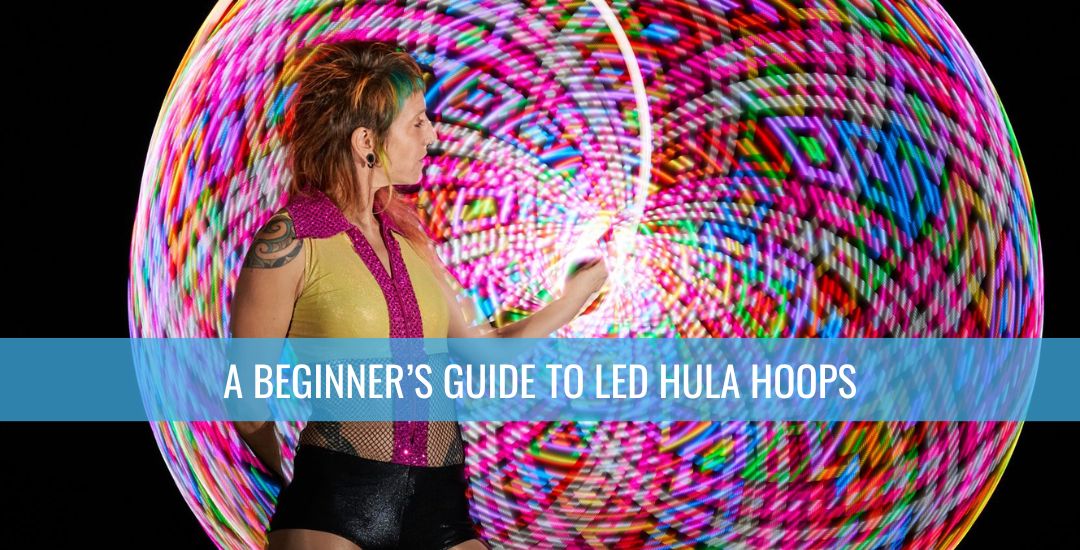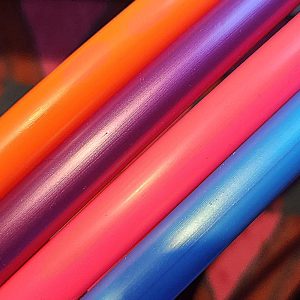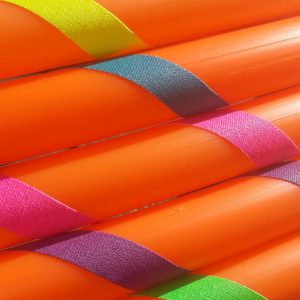It doesn’t take long after you start hooping until the allure of playing with LED hula hoops starts calling. I have a friend who used to coil and wrap glowsticks around her hula hoop to make a quick DIY light-up hoop. A great quick fix – well, kind of. It’s awkward, changes the shape of the hoop, and creates quite a bit of waste. With so many options available now, it’s easier than ever to get yourself a light up hoop. However, it can be tricky to know where to start or what to look for so here is our beginner’s guide to understanding all things LED hula hoop.
Look who’s hooping.
The first thing to consider is who is hooping and how they want to hoop. If you want an LED hula hoop for yourself, are you more interested in doing on or off body? Will you be using the LED hula hoop for private use and enjoyment or as more of a professional prop to perform with? Do you want to be able to program your own patterns in the hoop and/or sync the patterns it to music? Understanding the purpose of the hoop and who it is for will help determine things such as size, materials, and some of the LED hoop requirements. LED hula hoops can be a great gift, but it’s a good idea to try to suss out the sort of hooping it will be needed for, before buying one.
No matter what hoop you are buying, identifying who is hooping will help with determining the best hoop size and material. LED hoops are available in both HDPE and Polypro – just like regular day hoops. When it comes to sizing for an LED hula hoop, it’s a good idea to consider your choices and think about downsizing slightly as the LED’s make for a heavier hoop. This means you might not need to go as big as usual due to the extra weight.
Light it up.
When it comes to LED hula hoops there are a couple of base choices available: regular or smart.
Regular LED hoops are built using individual LED’s within the hoop. These hoops are capable of one or two modes and likely have less than 50 LEDs. You can find regular LED hoops from the $50 – $300 price range. For anyone starting out and wanting a fun hoop to play with at night, this is a great place to start.
Smart LED hoops are constructed using an LED strip which is programmed and controlled by a computer chip. These hoops are capable of over 500 modes and display intricate patterns and designs. There are usually between 100 – 220 LEDs inside a smart hoop, and they can cost between $200 – $900.
Both types of LED hoops are fun and super impressive at night! One pattern or one hundred patterns, as long as you are having fun with your hoop, you are looking good! At this stage, price and purpose are likely to impact your LED hoop type decision. Once you have narrowed your choice you can start to explore the options available.
Hoops got the power.
LED hula hoops obviously require power. One of the other main features to look at is the power source. There are two main types of batteries used for LED hoops. Replaceable and in-built rechargeable. Replaceable batteries allow you to carry spares with you so that you can switch them out as needed – and if you want to save on batteries in land-fill, get a few rechargeable replaceable batteries and have a couple charged up and spare at all times. In-built rechargeable batteries require downtime and an external power source you can plug into to keep them juiced up.
One impact that batteries can have on the hoop is how they affect the weight. When looking at different brands of hoops, you may find that additional weights can be placed in the hoop to help evenly distribute the weight. This weight adjustment may require you to take a step back and relearn a move or two with the new hoop, or spend some time getting used to the different feeling. Depending on the battery placement and distribution hoops can be more weighted on one side, and this is something to keep an eye out for. Again, depending on your purpose that might not be a problem.
What’s it made of?
The age-old question when it comes to choosing the right hoop, HDPE or Polypro? LED hoops will always weigh more than a regular hoop, due to all the wiring and batteries inside. The material choice can also impact the weight. HDPE is a highly durable material, it is denser than Polypro and therefore heavier. As Polypro is a thinner, more flexible, and lighter material it is also slightly less durable and more prone to cracks in cold weather. Deciding on your tubing type is another factor to consider when looking into LED hoops – something that comes down to personal preference.
It’s worth taking the time to do some research into all the options. If you have a chance to pick up and play with someone’s LED hoop be sure to ask them about some of the points we have highlighted here so that you can get a real understanding of how these things come together.






